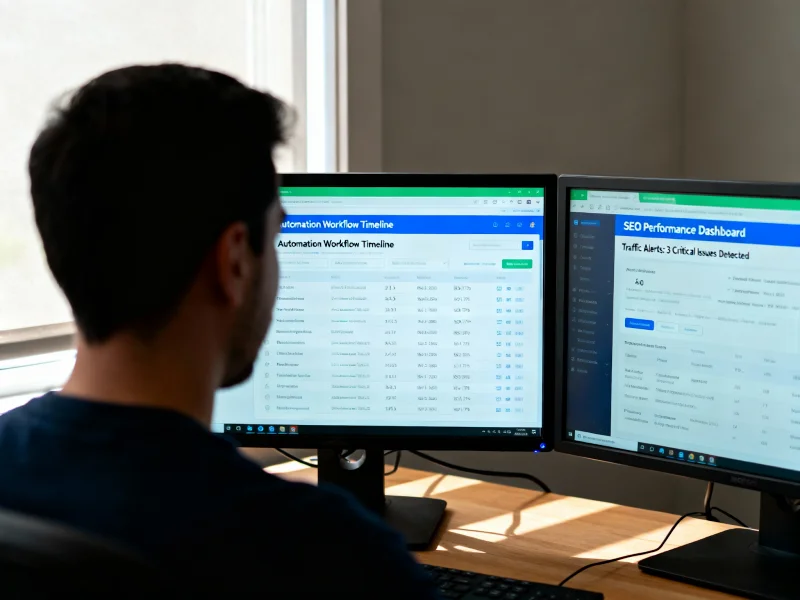Factors That Affect Website Design Costs and Project Timelines
Website design and website development involve multiple considerations influencing website cost and project duration. Complexity of web design, choice of platforms, and required functionalities can greatly alter budgets and schedules. Additionally, content generation, SEO strategies, and routine maintenance further impact overall timelines. Understanding how these elements interplay, including the value of developer expertise and agency selection, can help anticipate challenges and potential investments, encouraging thoughtful planning and informed decision-making.
When you build a website, the type of website you choose—whether it's a personal blog or a full-scale business website—can significantly affect the cost due to varying cost of website features and web development needs.
Key Takeaways
- Complexity of website type, such as e-commerce versus simple blogs, significantly influences design costs and development timelines.
- Choosing between custom-built solutions and platform-based development affects scalability, customization options, and associated costs.
- Advanced features like custom functionality, tailored UI/UX design, and third-party integrations impact both expenses and project duration.
- Skill level and efficiency of developers or agencies chosen can alter timelines and quality, with experienced developers often commanding higher fees.
- Budgeting adequately for ongoing website maintenance, including updates and security, ensures sustained efficiency and optimal long-term performance.
Website Type and Design Complexity
Most website design costs depend heavily on the type and complexity involved. A simple blog website, meant primarily for static content posting, generally involves lower design complexity, resulting in lower costs. Conversely, an e-commerce website frequently integrates features such as shopping carts, payment gateways, and product listings, greatly increasing expenses due to elevated structural demands. Portfolio websites emphasize showcasing creative projects, necessitating custom design elements prioritizing visual appeal and user experience. Non-profit websites typically incorporate donation forms and volunteer registration systems, further raising design requirements. Ensuring responsive design, allowing compatibility across various devices, also affects complexity and overall costs. Additionally, investing in responsive design can enhance user experience and improve search rankings, which may justify the higher costs. Selecting a simple template instead of a fully custom design can reduce expenditures substantially while maintaining quality.
Platform Selection and Technology Choices
When budgeting for website design, selecting custom-built solutions over existing platforms significantly affects cost and timelines. Each approach has distinct technology requirements, and the choice often depends on available technical expertise and integration capabilities. Additionally, ensuring forward compatibility with evolving technologies can prevent substantial future expenses.
Custom vs. Platform Solutions
Businesses considering website creation face two primary paths: opting for a custom-built solution or selecting an established platform. Custom solution benefits include unique branding tailored to reflect business identity, advanced integrations with existing systems, adaptability to future updates, and a distinct competitive advantage through specialized features. Conversely, platform solution drawbacks involve:
- Limited scalability that can restrain business growth.
- Restricted customization hindering unique design and functionality.
- Provider dependency affecting updates, support, and continuity.
- Template similarities compromising brand uniqueness and differentiation.
To select the best approach, businesses must carefully consider factors such as project budgets, anticipated growth, complexity of required features, launch timelines, and the strategic importance placed upon brand differentiation and tailored customer experiences.
Technology and Compatibility Choices
Selecting the appropriate technology stack and platform directly influences the budget, performance, and long-term maintainability of a website project. For instance, selecting front end frameworks such as React, Vue, or Angular affects development complexity, directly impacting project costs and timelines. Similarly, back end technologies like Node.js or Python influence scalability, affecting both upfront expenses and future adaptability. Platform selection also greatly impacts costs; e-commerce platforms like Shopify typically include ongoing subscription fees, while CMS solutions such as WordPress or Drupal vary in setup complexity and customization requirements. Compatibility considerations, including cross-browser performance and mobile responsiveness, also affect the necessary testing investments. Careful alignment of chosen technologies with business needs guarantees optimum performance, cost-efficiency, and lasting maintainability.
Functionality and Advanced Features
The incorporation of custom application development and third-party integrations greatly influences overall website design costs. While custom applications allow tailored functionality aligned precisely with business objectives, they typically require specialized technical knowledge and increased development resources. Similarly, third-party integrations expand a site's utility but vary widely in cost depending on their complexity and licensing fees.
Custom Application Development
Investing in custom application development enables companies to build specialized features and advanced functionalities tailored precisely to their operational needs. Clearly defining user requirements helps developers identify essential functionalities, facilitating accurate budget estimation. Detailed planning can clarify the necessary workload, thereby better aligning expenses and timelines.
Key considerations impacting custom development costs include:
- Project Complexity: Simple apps ($5,000–$15,000) versus complex ones (upwards of $250,000); complexity raises coding and testing demands.
- Design Level: Custom UI/UX incurs extra costs, often 15–25% of the project budget.
- Team Expertise and Location: Developer competency and geographic location greatly influence project pricing.
- Technological Demands: Incorporating advanced features like AI or implementing rigorous security measures adds considerably to project costs.
Third-Party Integrations
Integrating third-party tools and plugins can greatly enhance a website's capabilities, enabling functionality such as payment processing, e-commerce systems, and bookings. However, integration challenges can affect timelines and costs considerably. While simple plugins might be free, advanced features often carry fees ranging from annual subscriptions to significant one-time payments. A thorough cost analysis must factor in initial charges, development hours, and possible recurring expenses from subscriptions or API usage. Development expenses might range from $500 for basic integrations to upwards of $5,000 when customization is extensive. Additionally, implementing complex functionality requires increased developer involvement, extending project schedules through necessary testing and debugging phases. Ultimately, budgeting for integrations should align directly with business priorities, customer experience needs, and anticipated returns on investment.
Content Creation and SEO Optimization
Because content creation and SEO optimization greatly influence a website's visibility, they must be integrated strategically from the project's onset. Effective content strategy begins with thorough research, guaranteeing relevancy and enhancing user engagement. Strategic keyword integration into content positions the site effectively in search engine results, increasing organic traffic and relevance to target audiences.
Four critical considerations shape content creation and SEO optimization costs and timelines:
- Quality and Variety: Creating a website with diverse, quality content types such as blog posts and videos ensures broad audience appeal, particularly if you want to build your website successfully.
- Technical SEO Elements: Utilizing advanced elements like schema markup required for your website enhances search engine understanding.
- Internal Linking Structure: Establishing clear internal linking to improve content discoverability is a key part of the website project.
- Regular Updates: Consistent publication of fresh, optimized content sustains visibility and can increase costs if not carefully managed.
Ongoing Maintenance and Potential Upgrades
After launching a website with carefully crafted content and SEO, ongoing maintenance becomes a significant factor in its sustained effectiveness and functionality. Proper maintenance strategies include crucial tasks like software updates, regular security scans, content refreshes, and link repairs. Depending on the complexity of the website, technology stack selections, and security requirements, monthly maintenance can range from $5 for a simple website to upwards of $5,000 for extensive eCommerce platforms, introducing potential additional costs and possible hidden costs.
Cost optimization may involve modular designs or cost-efficient hosting options. Effective upgrade planning is essential, as custom developments and scalability enhancements entail higher expenses now but can prevent costlier fixes in the future. Clearly budgeting for ongoing maintenance, including service bundles or professional assistance, guarantees sustained performance, security, and long-term website success—particularly if you aim for a successful website redesign. When considering to redesign your website, understanding the detailed website redesign cost is essential, as the overall cost of your website redesign heavily depends on various factors.
Developer Expertise and Agency Considerations
When budgeting for building your website, businesses must carefully evaluate the expertise level of the chosen developers or partner agency, as this selection directly influences project success, cost, and timeline. Experienced developers have higher freelancer rates, justified by their efficiency, specialized skills, and high-quality results. Choosing a reputable website development company instead of freelancers offers additional advantages.
Key factors and factors that influence the cost of website development include:
- Specialized Expertise: Developers with niche skillsets, such as UX/UI or custom e-commerce platforms, typically attract higher project rates, which can also affect the cost significantly.
- Efficiency and Speed: Skilled developers complete tasks quicker, potentially offsetting higher hourly fees. This efficiency depends on several factors related to expertise.
- Agency Benefits: Team specialization, streamlined project management, better risk handling, and scalability, essential if your website requires complex features.
- Quality and Reliability: Paying more for experts often translates into superior outcomes and smoother project delivery, particularly if a professional-quality website is essential.
Understanding how many factors impact the cost to redesign a website is critical when determining your website redesign price. Ultimately, evaluating these aspects ensures you accurately estimate the cost based on actual website needs and properly anticipate the overall cost of redesigning a website, answering the common question, "How much does a website cost?" in a practical, informed manner. Additionally, services that website builders offer might help reduce costs, especially if creating a basic website for a small business.
Conclusion
At Authority Solutions®, we understand that the costs and timelines for website design are significantly influenced by various factors, including the project's complexity, technology choices, advanced functionalities, content quality, and ongoing maintenance needs. The expertise of our developers and agency professionals also plays a critical role in ensuring project success and effective budgeting. We encourage businesses to carefully evaluate their goals, resources, and long-term requirements, enabling informed decisions and strategic planning. By comprehensively understanding these elements, we guarantee that your web projects are completed efficiently, cost-effectively, and successfully.
Frequently Asked Questions
How much time is required to design a website?
Designing a basic website with a few pages can take anywhere from one to two weeks, depending on the scope. For a custom-designed website or a website redesign project, it can take several weeks or even months due to the complexity of the project. The time required depends on factors like the features needed, the website content, and the collaboration process with web design agencies.
How much should it cost to design a website?
The cost to design a website varies widely, typically ranging from $20–$100 per hour or $500–$10,000 per project. The cost of your website depends on the platform, whether you're building a new website or undergoing a website redesign, and the level of customization. Design agencies or freelancers may charge based on experience, and factors that impact the cost include design complexity, project size, and additional features.
How much should I pay someone to run my website?
Website management costs vary based on type:
- Small business websites: $100–$400/month
- E-commerce websites: $300–$1,000/month
- Corporate websites: $500–$2,000+/month
- High-traffic websites: $1,000–$5,000+/month
These costs may include maintaining the website, updating website content, and ensuring uptime and security. Factors influencing website costs include traffic volume and functionality.
How much does it cost for a company to maintain a website?
According to the breakdown:
- Professional blogs: $25–$75/month
- Small to medium business websites: $35–$500/month
- Multimedia websites: $300–$2,500/month
- Corporate websites: $200–$4,500/month
This website development cost includes updates, backups, monitoring, and tech support. The cost of website maintenance is essential to keep your website running smoothly, and it can impact the cost of your overall digital presence.
What is a fair price for a website?
A fair price depends on the business type and whether you're using WordPress or a web designer:
- Small Business Website: $640+ or $143.88
- Ecommerce (small to large): $5,000–$15,000+
The costs of website design and website development often reflect the website’s complexity, whether it's a custom website or a template-based build. Factors that affect the cost include design scope, functionality, and branding requirements.
How much does a graphic designer charge for a website?
Freelance graphic designers typically charge $30 to $150 per hour, depending on their experience. Beginners charge around $30/hour, while seasoned professionals can charge much more. These rates apply to visual elements that are part of the website redesign process or new website builds, including logos, icons, and layout design.
How much do website designers charge per hour?
Website designers charge $30 to $200 per hour, with an average around $75–$100. Pricing varies depending on experience:
- Entry-Level: $30–$50
- Mid-Level: $50–$100
- Senior Designers: $100–$200+
This reflects how design costs vary based on complexity of the project, custom coding needs, and time invested in developing a website.
What is a reasonable budget for a website?
A reasonable budget for a complete website ranges from $1,000 to $145,000, depending on the provider (freelancer, agency, or website builder). Monthly costs for maintenance can range from $0 to $500. The total cost of a website project also includes upfront costs, hosting a website, and post-launch support — all of which should be factored into your planning.
How much does the average website design cost?
The average cost of website design ranges from $1,000 to $10,000+ for small businesses, with larger custom websites costing up to $20,000+. Factors influencing website design costs include:
- Website complexity
- Features and functionality
- Design style and content requirements
These are important factors influencing the website budget and should be considered whether you're starting fresh or planning a website redesign.
How expensive is a good website?
A good website can range in cost depending on the platform and whether you choose a DIY option or a web development company:
- DIY with WordPress or Wix: ₹5,000–₹20,000/year
- With a development agency: ₹30,000–₹2,00,000+
The cost of a website increases with custom features, hosting, and ongoing support. Good design is essential for a successful website, but the costs vary greatly depending on your strategy and goals.









